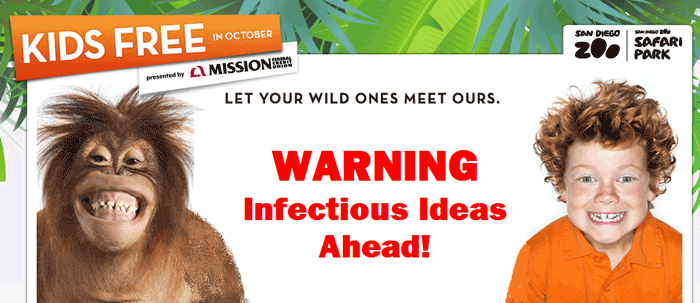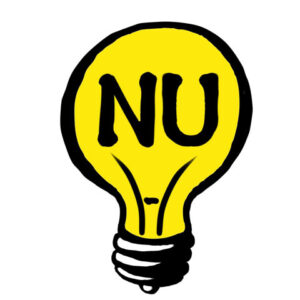 “Contagious: Why Things Catch On”
“Contagious: Why Things Catch On” by Jonah Berger is a lot more than a guide to online search engine rankings. It’s a primer for creating positive, viral, word-of-mouth buzz about our ideas, products, and ourselves. Here’s a short summary of why we should craft all our messages primarily for face-to-face communication and 6 ways to make people want to talk about them. Since I like talking about the San Diego Zoo and Safari Park I’ll be using them in my examples.
Those of us who create online content often forget that simple conversation is far more common and influential than what we see on the internet. According to statistics collected by Berger, verbal exchanges with our families, physically present friends, and co-workers account for 93% of our interactions with others. Only 7% of our contacts (at the most) occur online. The reason why online communications get so much attention is that they’re still somewhat novel and much more easily measured than face-to-face ones.
Giving Them Something To Talk About In 6 STEPPS
The characteristics of buzz-worthy products and ideas can be remembered with the acronym STEPPS. It is not necessary to have all of them present to create a viral message, but the more the better.
S = Social Currency
T = Triggers
E = Emotion
P = Public
P = Practical Value
S = Stories
San Diego Zoo Global’s brilliant October kids get in free campaign for 2013 hits five of the six points. And might hit the last depending upon what the family brings home as souvenirs.
Social Currency
Social Currency is how we look to others when we talk about a product or idea. Parents who talk about taking their children to the zoo or Safari Park in October score points by being seen as good parents. After all, they’re spending time with their kids in an educational activity that encourages the social virtue of conservation.
I’m not saying that the family won’t have a good time, or that the parents do not genuinely embrace their role as caring stewards of the environment and wish to pass this attitude on to their children. I’m just stating that it does make them look good to talk about taking their children to either of the parks.
Triggers
A trigger is something in our environment that reminds us of a product or idea. The billboard images of a grinning orangutan and a tousled red-headed boy brilliantly tie your internal image of your playful kids as little monkeys to the thought of visiting the zoo. If you’ve seen that image, every time you look at your wild child or grandchild, you may also think of going there. SD Zoo Global has turned your children into triggers for the parks.
Emotion
The image used in the 2013 campaign is amusing. Telling a joke or describing something cute and funny makes others feel as good as we do. As Berger says, if we care, we share. But we don’t share all emotions equally. High-arousal emotions like anger, anxiety, amusement, and awe get us excited and moved to take action to communicate our feelings to others. Sadness or contentment are more passive emotions and do not get passed on as often.
Unfortunately for conservation efforts, sadness at what we are losing is the primary emotion expressed in all too many messages. As a result, ideas about preserving, protecting, and restoring the natural environment aren’t as viral as they could be. Associating the conservation mission of San Diego Zoo Global with this amazingly cute and funny picture ensures that more people will talk about the parks and their efforts even if they don’t visit in October.
Public
The more visible the product or idea, the more likely it is to be talked about. The billboard images are very visible and graphically striking. But they are only around for a month.
This is the weakest point in the entire Kids Free in October campaign. Ideally, there should be some of what Berger calls ‘behavioral residue’ that can be worn or brought home to remind the family and friends of what a great experience they had.
Purchased park souvenirs like stuffed zebra toys are good for the zoo’s bottom line, but they do not act as a public announcement of their adventure. Items that people wear or carry around with them daily like t-shirts, gym or grocery bags are better for this purpose. But there are many families that do not purchase these and therefore their visit does not provide an additional boost to the SD Zoo Global message. One inexpensive idea would be to give the kids free “I’m a Wild One!” stickers for their school notebooks as they’re leaving the parks.
Practical Value
Helping others feels good. And information that saves time and money and helps people to have a good experience gets shared quickly. The kids’ free campaign hits two out of three. Free is a great price for an entertaining day at the park for your children or grandchildren.
Stories
We are a storytelling species. We like to listen to them We don’t memorize lists of facts and figures, we package them in narratives with a take-home message. But for stories to be effective to spread the word about an organization, product, or idea they have to be integral to the narrative.
Fortunately, the activities at the San Diego Zoo and Safari Parks are perfect for the creation of new, personal family stories that feature the parks. If a parent is talking about how their child was licked by a giraffe while feeding it and leaves out where they were, the person that is hearing the story will invariably ask. Giraffes aren’t very common in North America and the opportunities to feed them are even rarer. The park will get mentioned because it’s critical to the story and the fact that it was an endangered species may also get passed along.
So there you have it. 6 ways to get people talking about your ideas and products using the example of the 2013 Kids Free at the San Diego Zoo in October program.
